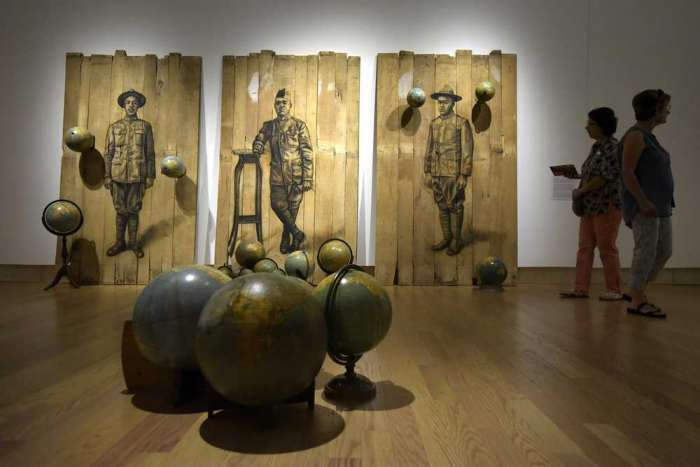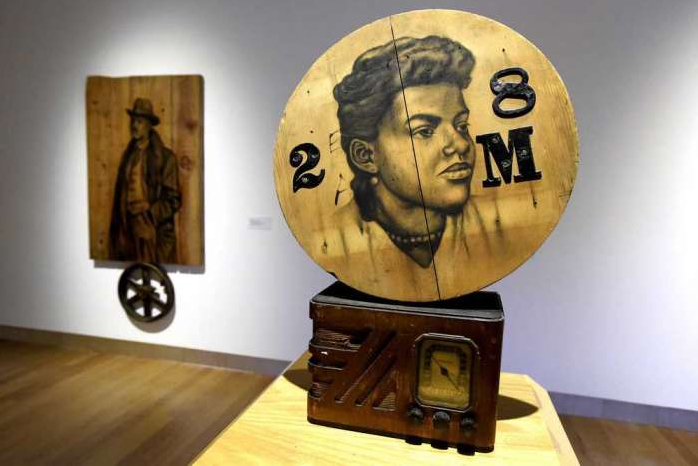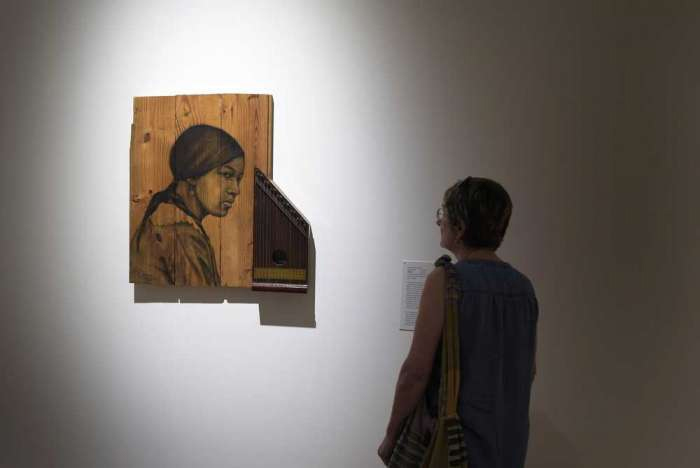By Charlie Patton, via jacksonville.com

Bob Self / Staff Photographer – The installation “Deep River,” which includes a mound of dirt littered with a pair of boots, a frying pan, a bugle, a pistol, a Bible, a tea kettle and an ax is part of the new exhibit, “Whitfield Lovell: Deep River” at the Cummer Museum of Art and Gardens.
At the heart of “Whitfield Lovell: Deep River,” a new exhibit at the Cummer Museum of Art & Gardens, is the installation “Deep River.”
At its center is a mound of dirt littered with objects — a pair of boots, a frying pan, a bugle, a pistol, a Bible, a tea kettle and an ax. The mound of dirt represents Camp Contraband, north of the Tennessee River near Chattanooga, where former slaves gathered after being liberated by Sherman’s March to the Sea during the Civil War.
The mound is surrounded by more than 50 portraits of African-Americans, painted on wooden tondos (a Renaissance term for a circular work of art). On the walls of the space, which is in back section of the Mason Gallery, images of a flowing river are projected. Occasionally the spiritual “Deep River,” sung by soprano Alicia Hall Moran, can be heard over the sound of rushing water.
But the “Deep River” installation is only part of “Whitfield Lovell: Deep River.” The 55-year-old African-American artist is known primarily for his portraits of African-Americans from the first half of the 20th century, portraits often painted on wood and often surrounded by found objects collected at flea markets.
Near the entrance to the Mason Gallery is a piece called “Pago Pago” (Pago Pago is the capital of American Samoa and served as naval repair station during World War II). “Pago Pago” consists of a portrait of an African-American soldier seated in a bamboo chair with 15 vintage radios stacked beneath the portrait, accompanied by the sound of Billie Holiday singing “I Cover the Waterfront.”
The first large area of the Mason Gallery features “Autour de Monde,” French for “Around the World.” It consists of three large portraits of African-American soldiers, painted on wood, surrounded by more than a dozen world globes of varying sizes.
Most of the next section of the gallery is taken up by “Flight,” an installation that includes more portraits on wood surrounded by more than 50 suitcases and a music stand holding the sheet music for the spiritual “Deep River.”
Nandini Makrandi, chief curator of the Hunter Museum of American Art in Chattanooga, which organized the exhibition, said that in creating the installation “Deep River,” Lovell clearly wanted to document the journey of African-Americans from slavery to freedom but to avoid portraying the experience in a negative way.
“A lot of artists depict the anguish of slavery but Lovell does not focus on that,” she said. “If you look at the individuals and you look at their faces, they are mostly calm and assured and confident.”
The entire exhibit “Whitfield Lovell: Deep River” traces the journey of African-Americans from the Civil War to the civil rights era, said Holly Keris, chief curator of the Cummer.
“It’s about a search for freedom and independence,” she said.
Keris also noted that the exhibition’s inclusion of a river motif is apt since the Cummer is located on the banks of the St. Johns River and the organization Cultural Fusion, of which the Cummer is a member, has designated 2015 “the Year of the River.”
Lovell’s work has appeared in numerous exhibitions at national venues such as the Seattle Museum of Art, the Smithsonian American Art Museum, the Whitney Museum of American Art, and the Metropolitan Museum of Art. In 2003, Lovell’s work was part of an African-American Masters exhibition organized by the Smithsonian, which was exhibited at the Cummer.

Bob Self / Staff Photographer – Above: “Autour de Monde,” 2008 by Whitfield Lovell. Lovell’s work “explores the legacy of African-Americans who fled from slavery in pursuit of freedom during the Civil War.”

Bob Self / Staff Photographer – 2 8 M, 2008 by Whitfield Lovell. Preview of the Whitfield Lovell show Deep River which has just been installed at the Cummer Museum of Art and Gardens, May 20, 2015. According to the museum Lovell’s work “explores the legacy of African Americans who fled from slavery in pursuit of freedom during the Civil War.”

Bob Self / Staff Photographer – A visitor looks at “Ardor,” 2003 by artist Whitfield Lovell at the Cummer Museum.
